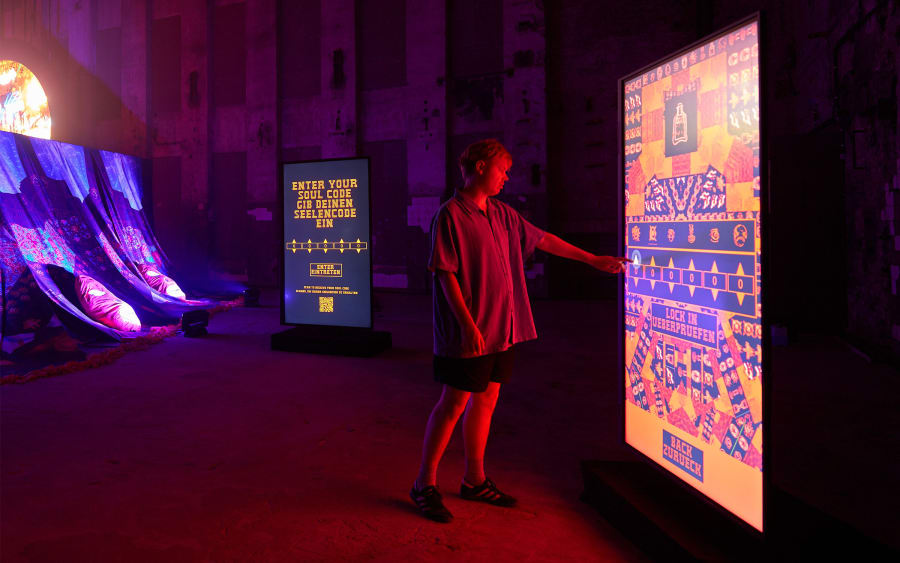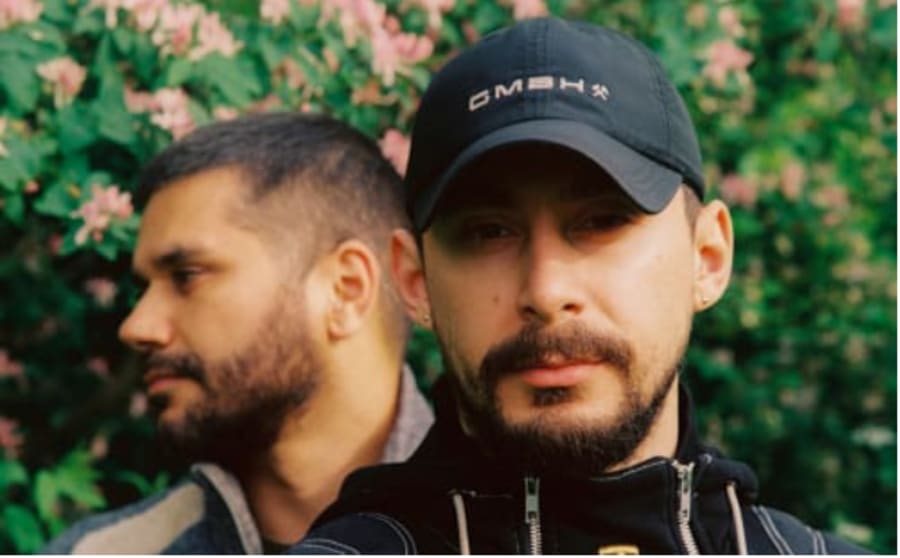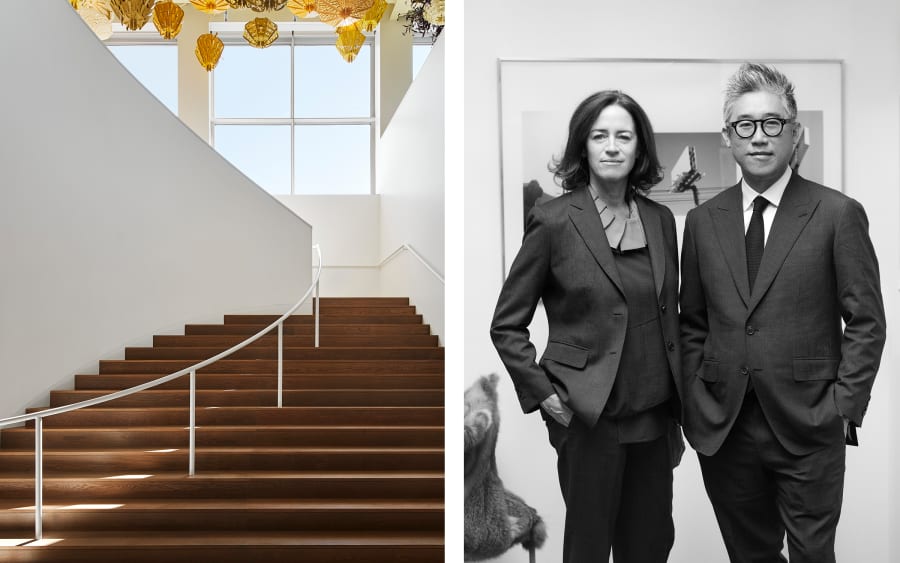On a recent sunny day in July, the former logistics hub of the Oberspree Cable Works, a massive factory complex on the River Spree in eastern Berlin, was at capacity. The factory floor – once part of a major manufacturing plant in the German Democratic Republic – was packed not with electrical cables, but with conceptual sculptures and assemblage works in wood and fiberglass.
Samples of sculptures by the Egyptian artist Iman Issa perched on shelves alongside adhesive materials, tools, and stacks of hard hats. Under an original factory crane with Cyrillic lettering stood stacks of wood samples that needed clearing out imminently before a massive Monica Bonvicini light sculpture arrived to be prepared for installation in Denmark.
‘We have a place where the [light] grid is made, and then we’ll basically do the whole electrical installation with a team here,’ explains Sandra Stemmer of the Bonvicini piece. With her business partner Holger Hönck, Stemmer is one half of the art-fabrication duo Stop Making Art, which has operated out of the riverside factory complex since 2018.
在這位德國藝術家於紐約貝浩登(Perrotin)舉辦的首次個展「When the Sun Hits the Moon」中,有幾幅畫作是初次亮相,主題為安東尼奧.卡諾瓦(Antonio Canova)的新古典主義雕塑中描繪的愛神厄洛斯與普姬幾乎接吻的場景。愛神不允許他的世間愛人看到他在光明中的樣子;當普姬拿著蠟燭對著愛神面龐的那一刻,這對戀人就永久地斷開了聯繫。Greven說:「我喜歡這個意象,因為我捕捉到的那一刻,他們還在互相對視,但未真正看見對方的面貌。他們仍處於黑暗之中,以內心注視和以內在擁抱。」
‘Even when I was studying, I would produce pieces for other artists,’ says Schwarzer, whose first fabrications include student work in the mid-1990s on a group show featuring Armleder and the American conceptual artist Lawrence Weiner as well as Carsten Höller’s 1999 participatory work, 'Ballhaus.' After working in Milan for the renowned art dealer Massimo De Carlo, Schwarzer moved to Berlin in 1999. 'I was immediately asked by artists if I could help them because I had some experience,” he says. 'Eventually, I had so much work that I made it official.'
Back then, Schwarzer says, he was virtually the only art fabricator in Berlin. ‘There were just a few in Europe. There was Mike Smith in London, who came up with the Young British Artists. In Switzerland, there were a couple people, and then there was me,’ he recalls. ‘Then, after 2000, all the artists moved here and needed help.’
Mixedmedia has worked with some of the biggest names in the art world, from Marina Abramovic to Rirkrit Tiravanija and Olafur Eliasson, eventually moving into the former factory in Kreuzberg where it operates multiple workshops for wood, metals, and 3D printing. Most recently, Mixedmedia produced a Kaspar Müller lamp for this year’s Art Basel in Basel and, for Kapwani Kiwanga, assembled the Canadian Pavilion at the Venice Biennale, a massive undertaking that required stringing together seven million tiny glass conterie, or seed beads, into 40 meters of glass curtains. ‘It was a lot of work in very little time,’ Schwarzer tells me. ‘There were 30 of us working in shifts, 12 hours a day, seven days a week. But it was very exciting and a beautiful work.’
‘A lot of what we do is find solutions,’ says Hönck. Unlike Mixedmedia, which does most of its fabrication in-house, Stop Making Art primarily acts as a consultant or middleman, contracting out to workshops, from metal-casting foundries to glass-blowing and lacquering workshops.
‘We act as the hub between the artists and the end fabricator to also really see where the limits are. And most of the time, it is a budget question,’ says Stemmer. Both Hönck and Stemmer got into fabrication in the mid-2000s while working for Elmgreen & Dragset, where they oversaw the fabrication of Van Gogh’s Ear, a public sculpture installed in New York’s Rockefeller Center in 2016, among other high-profile projects. After more than a decade, they struck out on their own in 2018. By then, the fabrication business was booming.
‘In Berlin, the art scene needed to be fed, so these things grew like mushrooms,’ recalls Stemmer. As opposed to ‘these big players like UAP that have companies in Shanghai and do monster projects,’ she reflects, 'I think in other cities, there aren't as many.' In addition to Mixedmedia and Stop Making Art, Berlin is home to Studio Violet; Saygel & Schreiber, which focuses on art in public spaces; and Bonack, which started in the late-1990s as a framing studio and later branched out into fabrication and installation, working with artists including Ai Weiwei, Douglas Gordon, and Wolfgang Tillmans.
‘I really do produce worldwide, but I prefer Berlin,’ says the artist Alicja Kwade, who works with Mixedmedia and Stop Making Art, among other fabricators in the city. ‘That has mainly to do with the fact that I have been working with most of the companies here for many years,’ she adds, citing the ‘precision and seriousness’ of her Berlin fabricators, but also ‘a very unconventional and trusting way of working together, which goes beyond pure business.’
Not everyone is willing to speak openly about working with fabricators. (Two artists asked not to be mentioned in this piece.) Despite growing awareness that contemporary monumental sculptural works are not made by a solitary artist chiseling away in a studio, bias persists against outsourcing production. The proficient and critical work of a fabricator can still be made to feel like a dirty little secret.
‘Why should it?’ asks Stemmer. ‘I mean, it’s obvious that Anish Kapoor couldn’t make this big bean himself.’ At times, Stemmer finds it perplexing when artists ask fabricators to conceal the collaboration. ‘This is not art, but it is creative work,’ she says. ‘If you make music, you have a music producer, and the producer’s role is always seen as important and credited.’
In contrast, she adds, ‘fabricators are usually not seen. And a lot of artists don’t really want them to be seen. That’s my impression. But they are so important, because most of the artists we work with don’t have the head space for [constructing their own work]. It’s not that they can’t; they simply shouldn’t. That’s why we called our company Stop Making Art. The [artists] should just have the idea and then we make it for them.’
For some fabricators, that invisibility is part of the appeal. ‘I provide ideas, but I don’t consider myself a contributor to the creative process,’ says Schwarzer. ‘For me, it’s fine the way it is.’ Still, he is sometimes taken aback when people are under the impression that the artist produces everything alone. ‘It’s still the prejudice in the art world that the artist does the work themselves. And people are surprised when they hear that’s not the case,’ he adds. ‘For me, it’s just daily business.’
Charly Wilder is a writer based in Berlin and Mexico City.
Caption for top image: Exhibition view of Lucy Raven, Ready Mix (2021) at Neue Nationalgalerie, 2024. Courtesy of the artist, Lisson Gallery, Dia Art Foundation, Staatliche Museen zu Berlin, Nationalgalerie and David von Becker. Photo: Andrea Rossetti.
Published on August 5, 2024.


